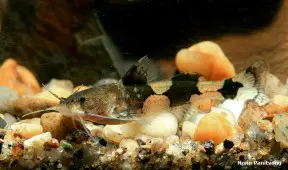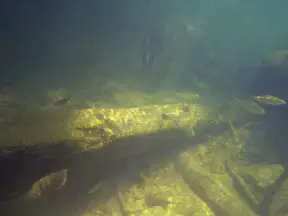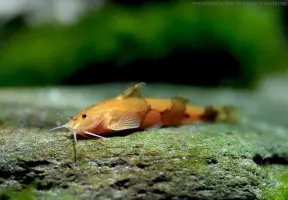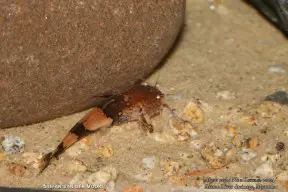Akysis vespa
Orange-Banded Hillstream Catfish
Etymology
Akysis: from the Ancient Greek α- (a-), meaning ‘lacking’, and κύστις (kustis), meaning ‘bladder’.
vespa: from the Latin vespa, meaning ‘wasp’, in reference to the yellow-orange and brown striped colour pattern, plus the painful sting that can be inflicted by the pectoral-fin spines.
Classification
Order: Siluriformes Family: Akysidae
Distribution
Appears endemic to headwaters of the Salween River basin around the border between Myanmar and Thailand, specifically the Megathat Chaung (Megathat stream) in the upper Ataran (known as the Kasat in Thai) drainage in Kayin/Karen State, Myanmar, and Hanthayaw River (Suriya in Thai), Tak Province, Thailand.
Type locality is ‘Stream “Chon Son” between Kyondaw and Phadaw, about 20 kilometers northwest of Payathouzu (at border with Thailand), 15°25’N, 98°15’E, Kayin State, Myanmar’.
Habitat
Members of this genus are near-exclusive inhabitants of swiftly-flowing streams and rivers with substrates generally consisting of any combination of sand, gravel and rocks.
The water is normally transparent to slightly turbid, though overall volume, flow, and thus the amount of suspended material tend to increase significantly during rainy periods.
Aquatic plants are not normally present though there may be patches of leaf litter or underwater structures such as fallen branches or roots protruding from banks.
In the Hanthayaw aquatic plants include Pogostemon helferi and a Cryptocoryne species while sympatric fishes comprise Acanthocobitis pictilis, Botia kubotai, Syncrossus berdmorei, Pangio fusca, Crossocheilus burmanicus, Parambassis pulcinella, Systomus orphoides, Pethia stoliczkana, Microdevario kubotai, Hampala salweenensis, Poropuntius scapanognathus, Glyptothorax dorsalis, Batasio dayi, B. feruminatus, Amblyceps caecutiens and Tetraodon cutcutia.
Maximum Standard Length
25 – 31 mm.
Aquarium SizeTop ↑
An aquarium with base dimensions of 45 ∗ 30 cm is more than sufficient, even for a group.
Maintenance
Not difficult to keep but should really be provided with a soft, sandy substrate since some of its time is spent completely buried, or with only eyes protruding.
It also appears to enjoy squeezing into crevices between rockwork and other solid surfaces so additional décor could include some water-worn rocks of various sizes, plus perhaps some driftwood roots and branches.
Although aquatic plants are unlikely to be a feature of its natural habitat some can be added if you wish with those that can be grown attached to rocks and wood, such as Microsorum, Anubias or various moss species particularly useful since they will not be disturbed by the fishes’ burrowing activity. Leaf litter may also be used.
Like many fishes that naturally inhabit running water it’s intolerant to accumulation of organic pollutants and requires spotless water in order to thrive.
It also does best if there is a relatively high proportion of dissolved oxygen and decent water movement in the tank, and weekly water changes of 30-50% tank volume should be considered routine.
Water Conditions
Temperature: 16.5 – 23.5 °C
pH: 6.0 – 7.5
Hardness: 36 – 215 ppm
Diet
Akysis species are primarily nocturnal micropredators feeding on small aquatic crustaceans, worms, insect larvae and other zooplankton.
They can be a little picky in the aquarium and may not accept dried foods although in some cases they will learn to take them over time.
At any rate they should always be offered regular meals of small live or frozen fare such as Artemia, Daphnia, bloodworm or glassworm, ideally after dark in order that they can demonstrate natural behaviour, though once settled most specimens will emerge at feeding times.
If the fish are very small you may need to chop the food accordingly.
Behaviour and CompatibilityTop ↑
Not especially competitive and should not be kept with much larger or more aggressive fishes.
Miniature schooling cyprinids such as Boraras, Microdevario, Celestichthys or smaller rasborins make good tankmates and if geography isn’t an issue many similarly-sized characins and livebearers should also work.
Other similarly-sized akysid catfishes plus smaller sisorids such as Erithistes, Erethistoides, Hara, Pseudolaguvia and many Glyptothorax spp. are recommended for the lower levels.
In addition, many balitorid loaches from genera such as Gastromyzon, Pseudogastromyzon and Homaloptera are also suitable, and it’s also proven to co-exist peacefully with freshwater shrimp.
It is not aggressive towards conspecifics and can be kept singly or in a group as preferred.
Sexual Dimorphism
Unreported, but sexual dimorphism has been reported in A. alfredi (Ng and Kottelat, 1998), A. fuscus (Ng, 1996) and A. microps (Ng and Tan, 1999).
In the former pair the anus is located anterior to a genital papilla in males, this structure having a genital opening covered by a fleshy flap at its tip and situated immediately posterior to the base of the pelvic fins.
In females the anus is located more posteriorly and the genital papilla is formed by a short appendage with an opening at the tip, this structure being situated approximately level with the poterior end of the inner pelvic-fin ray.
In A. alfredi the distance between the origin of the first pelvic-fin ray and the first anal-fin ray is less than in females (13.8-17.5% of standard length (SL) vs. 17.7-18.4%) but in A. fuscus the opposite is true.
The pelvic fins in males are also shorter than in females (12.9-14.2% SL vs. 14.1-15.5%), closer together (distance between pelvic fins 4.0-4.9% SL vs. 4.8-5.5%), usually overlapping posteriorly (vs. spread laterally) nand often curved to forma bowl-like shape (vs. straight).
In A. microps the genital papilla in males has a bulbous base with the genital opening at the tip not covered by a fleshy flap, while in females the genital opening is only partially covered by an appendage and there are no obvious differences in pelvic-fin morphology between the two genders.
According to Vishwanath et al. (2007) male specimens of A. prashadi possess a short, conical genital papilla immediately posterior to the anus while females have a flattened papilla with radial grooves at the pore.
Reproduction
A short report with images was published in the description paper (Ng and Kottelat, 2004), in which a successful spawning event in that species was apparently triggered by a significant decrease in temperature of around 44.6°F/7°C.
Several males were observed in pursuit of a gravid female, and the successful individual was allowed to wrap its body around that of the female at which point eggs and milt were released.
The eggs hatched 4 days post-spawn with the yolk sac fully-absorbed after 10 days.
Adult patterning was fully-developed after just 23 days.
NotesTop ↑
This species is among the few members of the family to be exported for the aquarium hobby and we’ve also seen it on sale under various names such as ‘orange-banded stone catfish’, ‘orange micro bumblebee catfish’, ‘Burmese orange mini bee catfish’ or more simply ‘wasp catfish’.
Though the majority of forms are yellowish to orange in colouration there appears to exist a bright red variant which to date we’ve only seen in photos.
It can be differentiated from all other Akysis species by the following combination of characters: head length 26.7-32.9% of standard length (SL); head width 23.2-25.8% SL; caudal peduncle length 19.4-23.3% SL; caudal peduncle depth 7.6-8.5% SL; interorbital distance 32.0-36.0% of head length (HL); eye diameter 12.0-16.0% HL; nasal barbel length 55.0-73.0% HL; absence of serrations on posterior margin of pectoral fin spine; caudal fin gently forked.
Although the body patterning is broadly similar to most Akysis spp. with a brownish base colouration and lighter, yellow markings the latter normally form wide bands in A. vespa which is a pattern rarely seen in congeners, while the yellow pigmentation on the snout uniquely extends to the base of the nasal barbels.
The most similar-looking congener is A. pulvinatus but it can be told apart from A. vespa by possession of a longer adipose-fin base (23.0-25.2% SL vs. 16.2-21.6% in A. vespa), deeper caudal peduncle (9.4-10.3% SL vs. 7.6-9.1%) and caudal-fin with longer lower lobe than upper (vs. both lobes more-or-less the same).
Members of the family Akysidae are often referred to collectively as ‘Asian stream catfishes’ since the majority are exclusive inhabitants of such environments.
All have four pairs of barbels, and within this larger grouping Akysis species are diagnosable by possession of tuberculate skin and cryptic colour patterning typically comprising yellowish bands or blotches on a brownish background.
Ng and Kottelat (1998) split the genus into the A. variegatus and A. pseudobagarius species groups based on various morphological characters, with the latter group subsequently reassigned to the genus Pseudobagarius (Ferraris, 2007) on the basis of the following shared characters: tip of snout extends anterior to margin of lower jaw; mouth subterminal; narial openings (anterior and posterior nostrils) relatively large and closely-set; caudal fin deeply forked.
Pseudobagarius spp. tend to have a relatively extended body shape compared with Akysis, while in the latter the snout tip extends only slightly beyond the margin of the lower jaw, mouth orientation terminal to slightly subterminal, narial openings relatively small and widely-spaced and caudal-fin truncate or emarginate.
In recent phylogenetic analyses the family Akysidae has been grouped into an assemblage informally referred to as ‘Big Asia’ where it occupies a basal position and is most closely related to the families Amblycipitidae, Sisoridae and Erethistidae, these apparently forming a monophyletic group alongside the Bagridae and Horabagridae.
The South American family Aspredinidae has been affiliated with Akysidae in the past, but is now considered more closely associated with the Doradidae and Auchenipteridae.
All akysids possess venom apparatus at the base of the dorsal and pectoral spines and though not dangerous to a healthy human can inflict a painful sting, so should be handled with care when being removed from the water for any reason or during aquarium maintenance.
References
- Ng, H. H. and M. Kottelat, 2004 - Ichthyological Exploration of Freshwaters 15(3): 193-200
Akysis vespa a new species of catfish (Siluriformes: Akysidae) from the Ataran River drainage (Myanmar). - Ferraris, C. J., Jr., 2007 - Zootaxa 1418: 1-628
Checklist of catfishes, recent and fossil (Osteichthyes: Siluriformes), and catalogue of siluriform primary types. - Kottelat, M., 2004 - Zootaxa 401: 1-18
Botia kubotai, a new species of loach (Teleostei: Cobitidae) from the Ataran River basin (Myanmar), with comments on botiinae nomenclature and diagnosis of a new genus. - Ng, H. H., 1996 - Raffles Bulletin of Zoology 44(1): 3-10
Akysis heterurus, a new species of catfish (Teleostei: Akysidae) from eastern Sumatra, with notes on Akysis hendricksoni Alfred. - Ng, H. H., 1999 - Raffles Bulletin of Zoology 47(2): 541-548
The Akysis of Myanmar: a review (Teleostei: Akysidae). - Ng, H. H., 2006 - Zootaxa 1150: 19-30
Akysis longifilis, a new species of catfish (Teleostei: Akysidae) from Myanmar. - Ng, H. H., 2007 - Zootaxa 1608: 51-58
Akysis pulvinatus, a new species of catfish (Siluriformes: Akysidae) from southern Thailand. - Ng, H. H., 2008 - Ichthyological Exploration of Freshwaters 91(3): 255-262
Akysis vespertinus, a new species of catfish from Myanmar (Siluriformes: Akysidae). - Ng, H. H., 2009 - Journal of Threatened Taxa 1(1): 2-8
Akysis portellus sp. nov., a new species of catfish (Teleostei: Akysidae) from the Sittang River drainage, Myanmar. - Ng, H. H. and D. J. Siebert, 2004 - Zootaxa 733: 1-8
A new species of the catfish genus Akysis (Siluriformes: Akysidae) from southern Borneo. - Ng, H. H. and M. Kottelat, 1998 - Journal of Natural History 32(7): 1057-1097
The catfish genus Akysis Bleeker (Teleostei: Akysidae) in Indochina, with descriptions of six new species. - Ng, H. H. and W. J. Rainboth, 2005 - Raffles Bulletin of Zoology, Supplement 13: 33-42
Four new species of Akysis (Teleostei: Siluriformes: Akysidae) from mainland southeast Asia, with comments on A. similis. - Page, L. M., R. K. Hadiaty, J. A. López, I. Rachmatika and R. H. Robins, 2007 - Copeia 2007 (2): 292-303
Two new species of the Akysis variegatus species group (Siluriformes: Akysidae) from southern Sumatra and a redescription of Akysis variegatus Beeker, 1846. - Sullivan, J. P., J. G. Lundberg and M. Hardman, 2006 - Molecular Phylogenetics and Evolution 41(3): 636–662
A phylogenetic analysis of the major groups of catfishes (Teleostei: Siluriformes) using rag1 and rag2 nuclear gene sequences.






